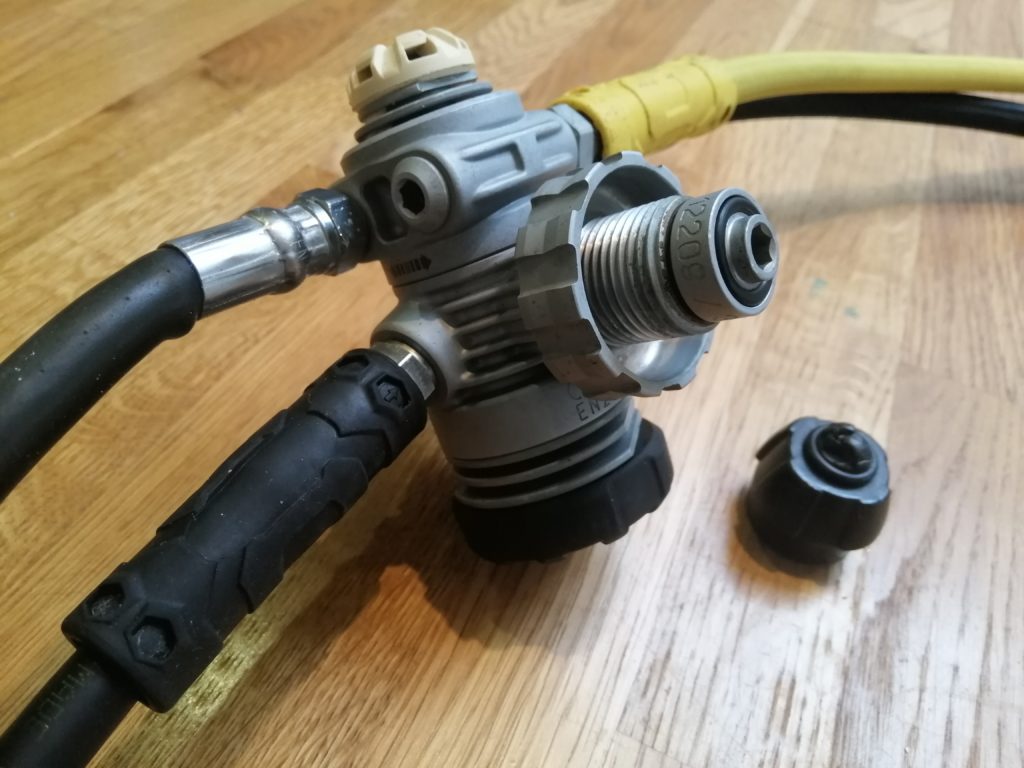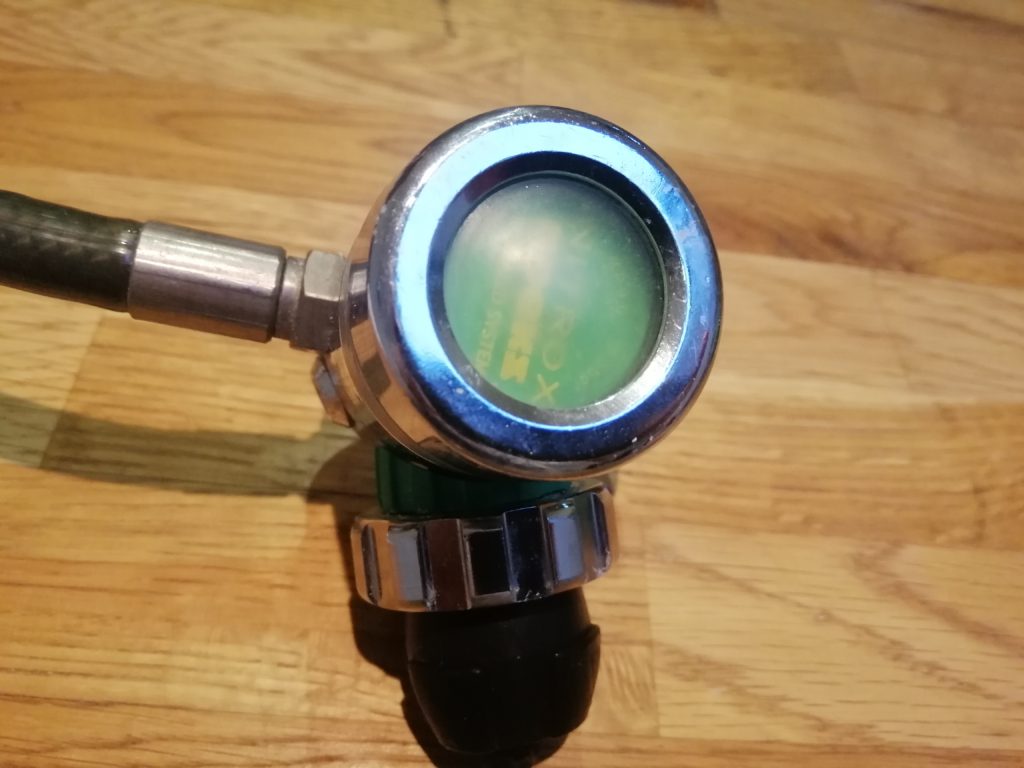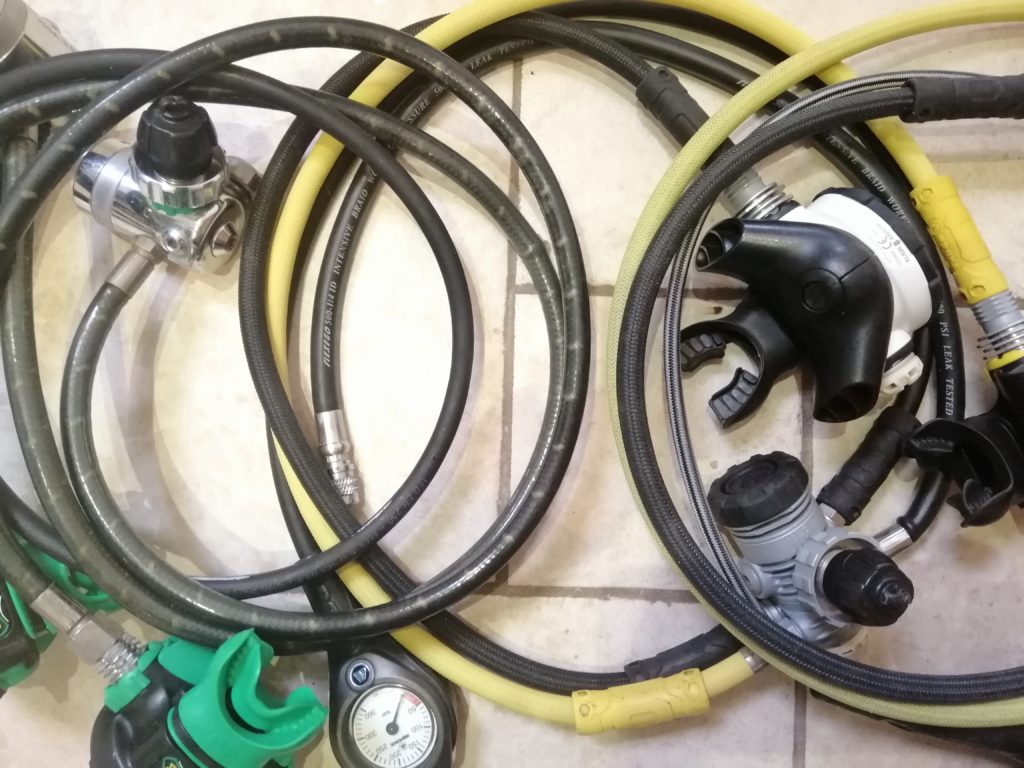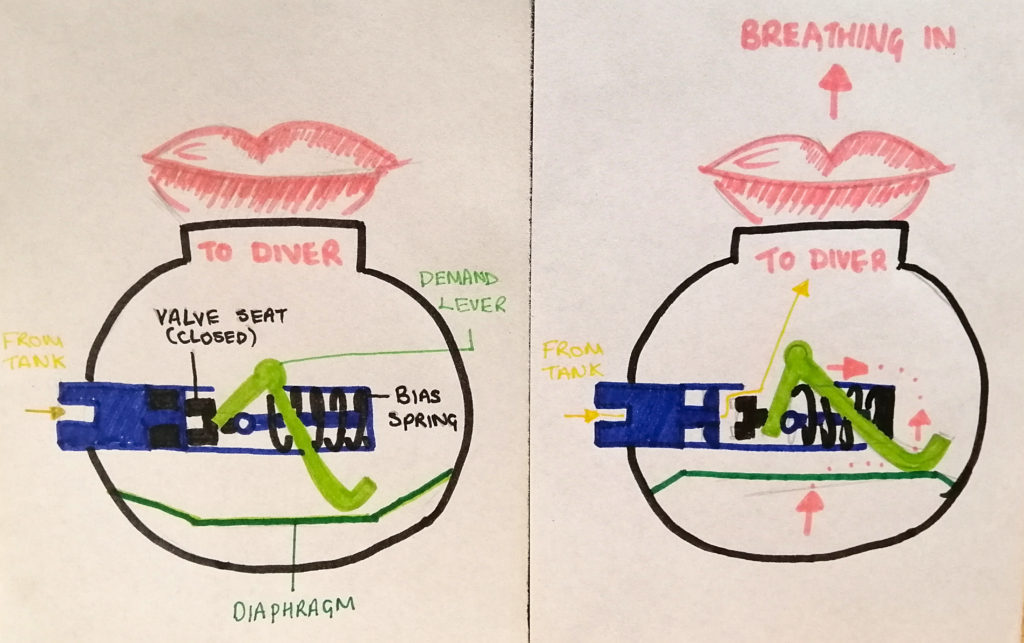A Simplified Guide To Buying The Best Scuba Regulator
Your most important piece of scuba gear? Most would say it’s a toss up between your computer and your regulator. They would be right.
Not only is it paramount to life support, it gives us our super power. Breathing underwater! So choosing a good one is very important.
If you trust the make and reliability of your reg there’s no telling where it could take you. On the other hand a faulty regulator is not only going to fill you with anxiety, it puts your life at risk.
Although price may still be a factor it is important you don’t let it influence your decisions too much. You should also consider what kind of diving you will be doing as cold water or technical diving may require specific features.
Regulators are made of different parts. When you buy them they are usually sold as a complete set however it is possible to buy the pieces individually and assemble it yourself if you know what you’re doing.
A complete set includes a first stage, second stage (primary air source), redundant second stage (alternate air source or octopus), SPG (pressure gauge) which may sometimes come with a depth gauge, compass or computer as well, and possibly a LPI (low pressure inflator). Everything is connected to the first stage with hoses.
So we will start from the top and working our way down.
Disclosure: Some of the links in this post are affiliate links. This means if you go through them to make a purchase we will earn a commission. Our aim is to help our readers through these links so everything we promote will be high quality products we personally believe in.
Regulator First Stage

It is the work of the first stage to convert the high pressure in the tank (200+ bar) down to a usable pressure (10 bar). The usable pressure air comes out at special ports.
As a minimum you should have three low pressure ports. Used for your primary air source, secondary air source, LPI and gauge. If you plan to dive in cold waters you will need an additional port for a drysuit inflator.
High pressure ports bypass the first stage and feed tank pressure information into an SPG or transmitter. You only need one but if you would like add a transmitter another port would be needed.
Some first stages also swivel so you can streamline the hoses the way you want them. If not it is worthwhile considering what your setup will look like in a fixed position. The two different types are also different size to prevent putting equipment in the wrong place.
First Stage Connection: DIN or Yoke Valve
There are two primary tank connections for your regulators DIN and Yoke.
Yoke connections work like a clamp which goes over the tank valve and is screwed in place.
You are probably most familiar with the yoke connections since they are most common in warm water countries and this is where more people tend to learn to dive. In fact in places like North America and Asia these may be the only type of connection you will see.
They have been the standard since scuba was invented and are popular with first time buyers. However increasingly manufacturers are looking to DIN connections for their regulators.

DIN consists of a threaded valve which screws in to the tank. If you want to remember the difference think DIN screws in.
It was named after Deutsch Industrie Norm, a mechanics, engineering and technology agency based in Berlin, Germany. However the original invention actually came from the U.S. in the 1950s. It was first released as the 5/8-threaded valve by Poseidon but was not very popular and so yoke became the main choice. When Deutsch Industrie Norm pressure tested the valves for industry use they made the valve their standard.
Since then it has been popular choice with technical, cave and cold water divers. The main reasons being:
- DIN can take higher pressure capacity. Up to 300 bar compared to the 200 bar capacity of yoke valves.
- Greater resilience to impact. There is an extremely unlikely chance that yokes can be knocked off the valve in overhead environments like wrecks and caves.
- The primary O-ring is less likely to get lost or damaged as it is located within the first stage of DIN regulators. This is opposed to in the tank of yoke valves.
- Tends to have a stronger connection.
An added advantage is that you can also easily adapt a DIN fitting to yoke valves. To do this you can either change the tank insert or purchase a small adapter.
The discussion of weather DIN is safer than yoke has been a popular one with divers for years. Even if the advantages are only small, DIN has 100% of my vote. However this does not mean that yoke connections are also safe. They have had the run of the market for decades and have proven to be a reliable choice.
Whatever you decide price should not vary too much. DIN valves were previously more expensive due to their use in high-end gear however now there is not much difference. If you change your mind you can also get a technician to covert your regulator later.
First Stage Mechanism : Piston or Diaphragm
First stage mechanisms fall into two categories piston and diaphragm.

Piston first stages have a low number of moving parts. They work by having external water pressure act on a piston.This simple design means they tend to have the highest performance and makes them relatively cheap to manufacture. In turn making them a popular choice for entry level and flagship models. However this also means they are not generally used in colder waters.
In higher end models advances insulation, material coatings and environmental seals have meant that they can be more adaptable for cold water.

Diaphragm first stages are more complex have tended to be lower performing until recent. They work by having pressure act on a flexible diaphragm, a push rod on the other side transmits the movement to the valve mechanism. However they have been more popular as most high and mid range regulators tend to use this design. They can be easily fitted with an environmental seal.
Both Piston and Diaphragm first stages can be split further into unbalanced or balanced types.
First Stage Control: Balanced, Unbalanced Or Overbalanced
Unbalanced first stages breathe harder at depth, when you have less air or when you need to share air with your buddy. They require different breathing effort depending on external conditions. The reason being that there is a difference in pressure on either side of the valve spring which needs greater amounts of effort to overcome the force as conditions change.
Balanced first stages breathe equally throughout the dive no matter what the conditions are. This makes them useful for cold water or current diving. They do this by routing high pressure cylinder air to both sides of the valve spring. This balances the cylinder pressure as the pressure you need to move the spring is always the same.
Overbalanced first stages instead of keeping a constant pressure actually supply you with more air as you go deeper, supposedly making breathing even easier. However there is a disadvantage to this as there is a greater chance of free flows because of the increased sensitivity.
If its so much easier why don’t manufacturers make all regulators balanced?
In short they do. Nowadays it is only a few lower end models that are still unbalanced because…
- In balancing a regulator the already complicated parts get even more complex. This in turn adds to the cost. Unbalanced regs tend to be cheaper.
* Other options if you are looking to reduce the cost is to go for a balanced first stage and unbalanced second stage. This will still give you relatively good performance.
- Not everyone may fully benefit from the features of a balanced regulator. Especially entry level divers and/or people who will only be sticking to shallow waters.
- Some divers claim to like having an unbalanced regulator as it acts as an indicator of certain limits (depth and low air pressure).
Environmental Seal

An environmental seal prevents water from interfering with the internal mechanisms of the first stage. This in turn stops ice forming inside during cold water diving which would result in free flow. They also prevent debris build up when diving in very silty, sandy or dirty waters.
In some places eg. Europe an environmental seal is required in waters as cold as 2-4’c.
They do tend to be more expensive but there may be an option to adapt or upgrade later.
Regulator Second Stage

The second stage reduces the pressure from the first stage (approx 10 bar) to ambient pressure a diver can breathe. Your respiratory system can only tolerate a differential of around 0.14 bar between the pressure surrounding your lungs and breathing air pressure.
In most cases you have two air sources, a primary and a secondary (used a backup). The secondary is usually an equal or lower performing version of the primary.
Second Stage Connection: Hoses

Did you know you can change the hoses on your regulators to suit your own style and comfort.
Typically the hose for your alternate will be a bright colour so it is easy to see in an emergency. It is usually yellow however you can now get lots of different colours. For your other hoses too.
You can also get longer or shorter hoses to suit your comfort. Again the alternate air source should be long so both divers can breathe from it at the same time.
Second Stage Mechanism: Downstream or Pilot Valve

Downstream valves open with the air flow and are most common. As you inhale a diaphragm pushes against a lever connected to a one way valve. This causes the valve to open and supplying you with air.
- They have a simple design which makes them reliable.
- They are easy to set which makes them easy to breathe from.
- If the valve fails it is almost always in the open position meaning you will have a free flow however you can still breathe from this whilst ascending to safety.
Pilot valves utilise different sized valves to provide greater airflow with less effort. As you inhale the diaphragm presses a lever on a small valve which in turn opens a larger main valve.
- They are more complicated which makes them more expensive (to buy and to service).
- They free flow easily so have a control switch.
Second Stage Control:
Balanced or Unbalanced
These offer the same advantages and disadvantages as the balanced and unbalanced versions of the first stage.
(Balanced breathes easier with changing conditions, unbalanced doesn’t)
In a typical second stage there is a a valve and spring. When you take a breath you open the valve and its closed agin by the tension of the spring. In a balanced second stage air is routed to the backside of the valve to help counteract the force from the spring. This means you don’t need as much effort to open the valve and so it is easier to breathe from, especially at greater depth.
Second Stage Control:
Venturi & Inhalation Adjustment

It is normal (even if your second stage is not balanced) that you will have some form of control over air flow inside your second stage. This is called a venturi. It is normally set by a service technician when assembling the regulator or after a service.
Inhalation adjustment is a common feature in higher end regulators and are usually coupled with a balanced second stage. It consists of an internal lever which allows you to tune your air flow to suit your needs. Under normal diving conditions you could tune it up to make breathing easier. Under non/pre-diving conditions you could tune it down to help prevent free flow.
It does this by increasing air flow behind the diaphragm which creates a vacuum and helps to keep the valve closed.
Summary
So if your feeling a little lazy (don’t worry, we get it ) here it is in short…
Ports = Minimum 3 low pressure, 1 low pressure. Additional required for dry suit diving and transmitters.
Connection = DIN boasts slightly more safety features and is more adaptable. Yoke has been the popular choice for years so it will probably be easier to find.
First stage mechanism = Piston models are simpler, cheaper and boast high performance. They are less suited to colder waters but can be adapted if needed.
Diphragm models are more complex, expensive and tend to have lower performance. However they are easier to fit with an environmental seal for cold water diving.
First stage Control = Balanced breathe consistently through a dive even at greater depth, lower tank pressure, buddy breathing, in currents and cold waters.
Unbalanced regulators are cheaper but can be harder to breathe from if used for anything other than shallow water diving.
Over balanced can make breathing even easier but can result in more free flows.
Environmental seal = An important feature in cold or silty water diving to stop freezing and free flow.
Hoses = A brightly coloured and slightly longer hose for an alternate air source however it is up to you what configuration you have.
Second stage mechanism = Downstream valves are more simple, common, reliable and easy to breathe from.
Pilot valves are more expensive and have a higher tendency to free flow but are easier to breathe from.
Second stage control = Same advantages and disadvantages of the balanced and unbalanced first stage.
Additional second stage control = Inhalation adjustment is an option in higher end models which lets you control your air flow.
Last But Not Least ...
Consider Brands
Choosing a regulator from a well known brand is optimal for two main reasons. Firstly they are trusted and probably have years of development and testing behind them. Secondly its much easier to find service centres especially in remote locations.
Commonly trusted brands include:
- Apex
- Aqualung
- Scubapro
- Mares
- Atomic
- Cressi
Consider Weight
It is popular nowadays to pack your regulators as part of your cabin baggage. This helps protect it but also saves on weight.
Many manufacturers have made lighter or smaller first stages with this in mind. However this shouldn’t be a feature that affects any of the other more important ones you want to have.
For example many travel specific regulators can only be used in waters above 10’c as the lighter composite materials they are made of have much lower thermal transfer properties. You may however be able to find models that offer both.
If this sounds up your street then maybe these travel regulators are what you’re looking for.
Consider Size
The size and weight of the second stage is sometimes a problem for women or younger divers. Some manufacturers make smaller models to help with this however you may find bubbles impede your view. Another option is to purchase a mouldable or smaller mouthpiece which can be changed at any time.
Consider Nitrox
Something that is worth checking is the compatibility of your regulators with increased oxygen blends (nitrox). The majority of models are compatible but if not most manufacturers offer a nitro version.
Testing A Regulator
It is hard to test a regulator out of the water. When testing a regulator it may make a strange honking or wheezing noise. This is because the diaphragm is dry and it won’t happen underwater. For this reason you should also not count the first breath as a dry regulator may stick
Make sure to inhale as gently as possible. The less effort this requires, the easier the regulator breathes. However this may also mean it is prone to free flow.
So that’s it! Now you have the knowelde to go out and not just find the best regulator but the best regulator for you.
But if there is something you are still confused about then go ahead and leave a comment below.
Like this? Then help us grow a little and give it a share. Your voice is louder than you think!
Related Posts...
Want More?
Sign Up for updates straight to your inbox! Woohoo!

